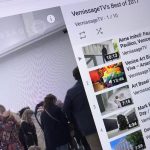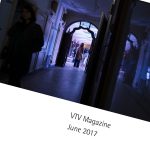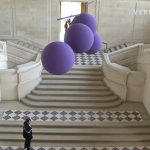Xavier Veilhan represents France at the 57th International Art Exhibition – La Biennale di Venezia. For the French Pavilion, Xavier Veilhan conceived a musical space in which professional musicians from all over the world work throughout the duration of the exhibition, which is called Studio Venezia. On the occasion of the preview days of the Venice Biennale, we had the chance to speak with Xavier Veilhan about his project. In this interview, Veilhan talks about the basic idea behind project, his connection to music and the kind of music he likes, how he chose the musicians, the difference between music and visual arts, and how Studio Venezia relates to Kurt Schwitters’ Merzbau.
Curated by Lionel Bovier and Christian Marclay, Xavier Veilhan’s Studio Venezia brings together musicians, sound technicians, programmers and producers, amongst others. Numerous instruments – familiar ones such as a grand piano, synthesizers, drum kits, as well as more exotic musical tools such as the Cristal Baschet (in this video played by Frédéric Lo) – are integrated into the space, and enable musicians from different horizons and genres (from classical to electronic and from new music compositions to folkloric styles) to work on site, either individually or collaboratively. Rather than attending concerts, visitors will instead be invited to listen, watch and bear witness to musical creations in progress.
Xavier Veilhan: Studio Venezia. French Pavilion at Venice Art Biennale 2017. Exhibition walk-through and Interview with Xavier Veilhan, Venice (Italy), May 9, 2017.
> Right-click (Mac: ctrl-click) this link to download Quicktime video file.
Transcript:
The first title for the show was “Musical Merzbau” and we changed it because the show is now a traveling show, so it’s called “Studio Venezia” and it will be called “Studio Lisboa” and “Studio Buenos Aires” next year and the idea behind it is to invite a great group of… a great amount of musicians to use the recording studio as a platform to record like in a proper studio but the studio itself is also a sculpture so it’s an architectural installation.
Well I made several experiences with musicians but I wanted to develop this and focus on the very moment where the music is appearing so not… not the music as we know it, all the data, all that we are carrying around on our phones or in our cars and in the city, but more the moment before it is really appearing as something that will be memorized. So the studio is a proper place for this experience because it’s, it’s the very delicate moment where the musicians are invited to produce something, but they also can fail and they can take a chance, so I’m interested in inviting people to share this moment of fragility and I wanted really also with this environment to get something very soft and very not into something loud or something impressive, but more something delicate and fragile.
I try to keep the relationship to music as an amateur, so for me it’s very important to have this love relation to music that is not into the making but into the enjoying the music. So I am not a real connoisseur but I am… I am interested in music because also it’s a symmetrical relation to visual art and what music can provide is different from what visual art can provide and there is a sense of time and chronology in both visual art and music that is very different but that is like complementary.
Yeah, it’s a probably… the main difference, is sensation and I’m interested in the music because it’s more physical and it gives an approach that is obviously intellectual everything is going through the brain, but it’s also physical in terms of it can make you dance or cry or adding goose bumps or…, so I try to bring this level of emotion into art, into visual art.
Well, we worked with an acoustician, Pierre Hugonnet on designing the spaces so that hey are very different from each other, so for example there is the big large room that is fairly bright and that is more adapt to people singing for example and when, when the… studio two is more devoted to louder instruments like horns or like drums and then there is the green room, where we are actually that is both where the instruments are stored, but also where the musician can rest and where I have my desk where I can host the different musicians, but also work on my other projects, because I will be here for the whole duration of the show, which is 7 months.
We started with the… with Christian Marclay, who is one of the two curators with Lionel Bovier and we talked a lot about what could be integrated in terms of direction and then we hired three other programmers from Venice but in very different fields, so we have a Baroque music, classical music, but also we have experimental Jazz and Electronics and Pop, so what I was interested in is not to represent everything in music but more to have a different approach but the feeling that they share, that all the musicians share is more the sense of curiosity and an interest into sound as a material, as a base of any work in music, so it’s not about melody or text it’s more about textures for example.
Probably Hip-Hop… but I’m listening to a wide range of different music and I’m interested in the duration also, so for example I love to listen to very long pieces like Brian Eno “Thursday Afternoon”, for example, that is a 1 hour, so it’s 60 minutes and it’s very strange because I also like to listen to The Ramones for a song that is one minute and 20.
Yes, I also listen to a lot of classical music but that is mostly a hundred years old I would say, so at the beginning of the last century I’m very interested into classical music and french music specially.
Well, first the Merzbau was the origin of a certain conception of art that could be something global that the people could enter in and not only a sculpture that you could go around but the sculpture that could be around you and I’m interested in this period in the history, like, for the music, and from the Russian Revolution I would say to the forties, to the Second World War I’m especially interested in architecture, music, but also sculpture and so it was a very intense time for creativity I think, but what I’m interested in is how we can link a certain feeling of modernity of today with this original feeling for modernity. So, of course we can’t be naive about it and there’s a lot of Utopia that we can’t deal with any more, but there is a certain strength that was behind, for example the Russian Revolution and Constructivism and Suprematism or the Futurists in Italy that I’m very interested in.






